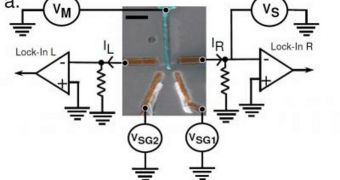Physicists have announced that they were finally able to demonstrate quantum entanglement in particles inside solid-state systems, which is a world first. Until now, the amazing effect has only been proven to exist in photons navigating optical systems, but never in solid-state devices. Two of the most important applications that immediately come to mind refer to producing new devices to innovate quantum computing, and to further expanding on the basis for secure, quantum communications, e! Science News reports. The researchers involved in the new study came from France, Germany and Spain.
The thing that makes this achievement so amazing is that solid-state systems are a lot easier to incorporate into existing devices, whereas optical ones still require a number of new technologies that are not yet available. With the new breakthrough, the elusive goal of constructing a working, stable quantum computer is brought a lot closer. This new class of devices promises to provide amazing speeds and performances, as well as code-cracking abilities never before encountered. Details of the experiment will be published in an upcoming issue of the respected journal Physical Review Letters, and have already been highlighted with a Viewpoint in the January 11 issue of the journal Physics.
Quantum entanglement was demonstrated in optical systems when entangled photons were split apart using a beam splitter. They continued to exhibit the quantum property, and so the principal was proven. In the new experiments, electrons trapped in superconductors were used instead of photons in optical systems. The international team managed to demonstrate the same effect using this setup, which allows for the formation of Cooper pairs of electrons.
As these pairs (which are similar to quantum entangled photons) move through a superconducting bridge as it is being cooled, they eventually reach a carbon nanotube that is only a few thousands the width of a human hair in diameter. While some Cooper pairs remain locked together, others split, as the nanotube is meant to play the same role as a beam splitter. The electrons that break their pairs remain entangled, however, each of them ending in a different quantum dot. These structures are located just one micron away from one another, but the distance is significant enough to make this demonstration the equivalent of proving photon entanglement in optical systems.

 14 DAY TRIAL //
14 DAY TRIAL //